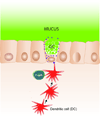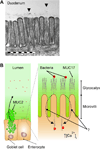The mucus and mucins of the goblet cells and enterocytes provide the first defense line of the gastrointestinal tract and interact with the immune system
- PMID: 24942678
- PMCID: PMC4281373
- DOI: 10.1111/imr.12182
The mucus and mucins of the goblet cells and enterocytes provide the first defense line of the gastrointestinal tract and interact with the immune system
Abstract
The gastrointestinal tract is covered by mucus that has different properties in the stomach, small intestine, and colon. The large highly glycosylated gel-forming mucins MUC2 and MUC5AC are the major components of the mucus in the intestine and stomach, respectively. In the small intestine, mucus limits the number of bacteria that can reach the epithelium and the Peyer's patches. In the large intestine, the inner mucus layer separates the commensal bacteria from the host epithelium. The outer colonic mucus layer is the natural habitat for the commensal bacteria. The intestinal goblet cells secrete not only the MUC2 mucin but also a number of typical mucus components: CLCA1, FCGBP, AGR2, ZG16, and TFF3. The goblet cells have recently been shown to have a novel gate-keeping role for the presentation of oral antigens to the immune system. Goblet cells deliver small intestinal luminal material to the lamina propria dendritic cells of the tolerogenic CD103(+) type. In addition to the gel-forming mucins, the transmembrane mucins MUC3, MUC12, and MUC17 form the enterocyte glycocalyx that can reach about a micrometer out from the brush border. The MUC17 mucin can shuttle from a surface to an intracellular vesicle localization, suggesting that enterocytes might control and report epithelial microbial challenge. There is communication not only from the epithelial cells to the immune system but also in the opposite direction. One example of this is IL10 that can affect and improve the properties of the inner colonic mucus layer. The mucus and epithelial cells of the gastrointestinal tract are the primary gate keepers and controllers of bacterial interactions with the host immune system, but our understanding of this relationship is still in its infancy.
Keywords: bacteria; inflammation; inflammatory bowel disease; mucosa.
© 2014 John Wiley & Sons A/S. Published by John Wiley & Sons Ltd.
Figures



References
-
- Schade C, Flemstrom G, Holm L. Hydrogen ion concentration in the mucus layer on top of acid-stimulated and -inhibited rat gastric mucosa. Gastroenterology. 107:180–188. - PubMed
-
- Gill N, Wlodarska M, Finlay BB. The future of mucosal immunology: studying an integrated system-wide organ. Nat Immunol. 11:558–560. - PubMed
Publication types
MeSH terms
Substances
Grants and funding
LinkOut - more resources
Full Text Sources
Other Literature Sources
Research Materials
Miscellaneous

